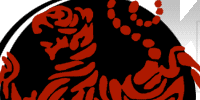 |
 |
 |

Welcome
to Our Website!
UechiKarate.Net
provides
information about Uechi-Ryu Karate and the
martial arts. We hope you
enjoy our website, designed to give you
information about our style of
martial arts.
What is Karate?
"True karate is this:
that in
daily life one's mind and body be trained
and
developed in a spirit of humility, and
that in critical times, one be
devoted utterly to the cause of justice."
-- Gichin Funakoshi
 Karate translated either
means
"Chinese hand" or "Empty hand" depending
on
which Japanese or Chinese characters you
use to write it. Karate translated either
means
"Chinese hand" or "Empty hand" depending
on
which Japanese or Chinese characters you
use to write it.
Okinawan Karate styles tend to be hard and
external. In defense they
tend to be circular, and in offense
linear.  Okinawan
Karate styles tend to place more emphasis
on rigorous physical
conditioning than the Japanese styles.
Japanese styles tend to have
longer, more stylistic movements and to be
higher commitment. They also
tend to be linear in movement, offense,
and defense. Okinawan
Karate styles tend to place more emphasis
on rigorous physical
conditioning than the Japanese styles.
Japanese styles tend to have
longer, more stylistic movements and to be
higher commitment. They also
tend to be linear in movement, offense,
and defense.
Both tend to be high commitment, and tend
to emphasize kicks and
punches,
blocks, strikes, evasions, throws, joint
manipulations and a strong
offense
as a good defense. Karate techniques
consist basically of hand and foot
techniques. Hand techniques are divided
into defensive or offensive
moves.
Foot techniques are divided into kicking
techniques; snap and thrust
kicks.
Other important elements of Karate include
stances, posture, body
shifting,
hip rotation, and breathing.

|
Training differs widely but most of the
Karate styles emphasize a
fairly
equal measure of basic technique training
(kihon), sparring (kumite),
and
forms (kata). Forms are stylized patterns
of attacks and defenses done
in
sequence for training purposes.
An art of self-defense as well as a sport,
Karate has in recent decades
proliferated worldwide. It is one of the
most widely practiced of the
Asian
martial arts, with a large following in
the U.S., Japan and Europe.
What
is Uechi-Ryu Karate?
Uechi-Ryu is traditional
Chinese-Okinawan self-defense, as
interpreted by Master Kanbun Uechi,
his son Kanei Uechi, and students of their
art. Uechi-Ryu has its
origin in the ancient Chinese tradition of
martial arts; Kanbun learned
the system Pangainoon ("half-hard, half
soft") in China after fleeing
Japanese military conscription in his
homeland of Okinawa. The system,
which has gone by the name Glare in the
Eyes with Fast Hands is based
on the movements of the dragon, tiger and
crane. Uechi's students,
grateful for his many years of
instruction, renamed the system "The way
of Uechi". Uechi-Ryu today is taught
undiluted in many dojos from
Okinawa to France to the United States. It
is not an Americanized,
smoke-and-mirrors creation of a commercial
karate instructor, it is
efficient and disciplined self-defense
through karate, the art of
weaponless fighting.
Uechi-Ryu provides a unique approach to
the martial arts. Uechi-Ryu
uses deadly and reliable strikes to
vulnerable targets to defeat foes,
but lacks the flash and endless variety of
some styles. Uechi-Ryu is
application oriented and avoids high
kicks, spinning techniques, flashy
exaggerated blocks, or many jumping
techniques, since these leave a
fighter vulnerable to attacks and throws.
Uechi-Ryu uses soft blocks to
redirect the force of an enemy's attack,
instead of using karate's more
traditional hard blocks, which require you
to counter your opponent's
strength. These soft blocks also set up
opportunities for
counterattacks and throws.
All of Uechi-Ryu builds upon the
principles found in Sanchin kata, its
first form. Advanced Uechi-Ryu consists of
expansions of these
principles rather than an assembly of
unconnected techniques, so
Uechi-Ryu builds a solid foundation for
its students' progress. Sanchin
stance is fundamental to all Uechi kata,
and is designed to protect
karate students and allow them to use
their bodies to their fullest.
Its back posture, tight stomach,
locked-down shoulders and turned in
elbows allow practitioners to channel the
power of their legs into the
strikes and blocks their arms make. A
short stance, Sanchin provides
the stability of a longer stance, but
reduces the vulnerability of the
front leg to kicks and sweeps and allows
greater mobility.
Uechi-Ryu is a grappling style and permits
the grabbing of legs and
arms, (something many styles forbid). Many
of these grabs lend
themselves to takedowns, others provide
chances for counter attacks.
Copyright ©
2001-2018
UechiKarate.Net. All Rights
Reserved. • Last
Update: June 2018
|
 |
 |
 |


